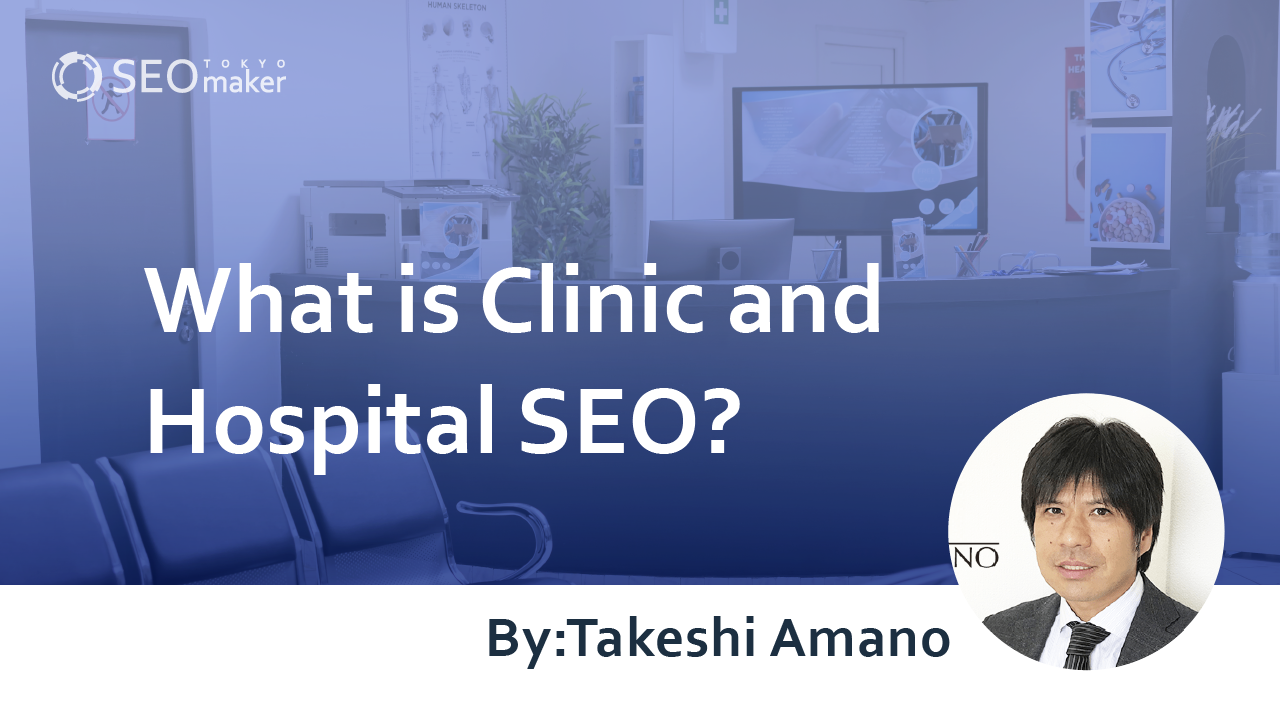What is Clinic and Hospital SEO? : Explaining SEO Strategies for the Healthcare Industry
contents
- 1 Reasons for Clinic and Medical Facility SEO
- 2 SEO Measures for Clinics and Hospitals
- 3 Keywords Examples for Clinics, Hospitals, and Medical Facilities
- 4 Flow of SEO Measures for Clinics, Hospitals, and Medical Facilities
- 5 Clinic, Hospital, and Medical Facility SEO Strategies
- 6 Common SEO Questions for Clinics and Hospitals
- 7 Summary

Recently, partly due to the impact of the coronavirus which became widespread in 2020, there has been an increase in online activities across society.
In this context, it is effective for clinics and medical practices to implement SEO strategies to attract patients. By executing SEO measures, the traffic to their websites increases, which can lead to more visitors converting into actual patients.
In this article, we’ll explain the SEO strategies that clinics and medical facilities should consider. We’ll convey key points that even beginners can understand, drawn from Tokyo SEO Maker, a specialized SEO website.
Reasons for Clinic and Medical Facility SEO
When a clinic or medical facility implements SEO on its website, it can increase website traffic by appearing higher in search engine results. As a result, attracting search users to the clinic’s website can potentially lead to visits to the facility.
Furthermore, search users often consider the reputation of clinics and medical facilities. By establishing a website and fulfilling the role of a medical institution, the clinic’s online visibility may increase.
Why SEO is Necessary in the Medical Industry
Let’s explore why SEO is essential in the medical industry.
Building Trust with New Patients
One significant benefit of implementing SEO in the medical industry is building trust with new patients. When individuals seek out a new medical facility, they often search online to alleviate any uncertainties.
For example, when someone experiences sudden abdominal pain and considers visiting an internal medicine clinic in Shinjuku, they may search for “Shinjuku Internal Medicine.” As a result, clinics in Shinjuku that appear in search results have an advantage. Particularly, clinics that have implemented SEO and created content are more likely to rank higher and gain trust from patients.
Patients entrust a vital part of their health to medical facilities, so they often harbor some level of anxiety. SEO tactics serve to alleviate these concerns and encourage patients to visit the facility.
Automated Attraction from Your Website
By implementing SEO strategies to ensure your pages rank higher, your website can serve as an advertisement, automatically attracting search users . This is because being ranked at the top (on the first page) of search results increases the visibility of your site.
Once your website can attract enough visitors, there may no longer be a need for traditional advertising methods such as flyers or newspaper ads. This is because users will find your website through their own searches, without the need for additional advertising.
Being able to attract visitors from your website can also lead to a reduction in advertising costs. If you’re struggling with rising advertising expenses or ineffective results, considering SEO strategies may be beneficial.
Expanding Your Target Area
One of the advantages of SEO is the ability to reach users across various areas on the internet. This means that your medical facility can attract patients not only from the immediate vicinity but also from a broader region.
By implementing a method called “Content SEO,” as we’ll discuss later, you can enhance trust from patients through the information you provide, thus cultivating a following for your facility. As a result, even if your medical facility is located a bit farther away, patients may still choose to visit.
Therefore, if you’re looking to broaden your target area, implementing SEO strategies is highly recommended.
Is SEO Necessary for Hospitals?
With the widespread use of the internet, people now turn to online searches for almost everything, including hospitals. Patients without a regular hospital will likely search online first. Consequently, a hospital’s website has become indispensable for attracting and retaining patients.
However, simply creating a website is not enough; without SEO, it’s challenging to attract and retain patients. Since most users only look at sites that appear at the top of search results, if your website isn’t ranked high, it may not receive any traffic.
Especially in areas with high competition, where multiple hospital websites are displayed, SEO becomes a crucial factor in attracting and retaining patients.
SEO Strategies Suited for Hospitals
In today’s world, where people search for hospitals online, SEO strategies have become crucial. Here, we’ll introduce three SEO strategies suitable for hospitals
Creating High-Quality Content with EAT in Mind
When search engines rank content, they consider its quality. One key aspect Google has emphasized in recent years is EAT: Expertise, Authoritativeness, and Trustworthiness. Content that meets these criteria is evaluated as high-quality.
In fields like healthcare, where user health and well-being are significant, creating content with a focus on EAT becomes even more essential.
Related article: What is SEO Strategy That is Not Affected by Core Algorithm Updates?
Implementing Long-Tail SEO
Long-tail keywords refer to phrases that consist of multiple keywords, rather than just one. By combining multiple keywords, competition decreases, making it easier to rank higher. Moreover, the broader range of keywords increases the audience reach.
For example, by combining keywords like “Shinjuku Dermatology” and “Shinjuku Dermatology Allergy,” your content can rank higher for long-tail keywords. This strategy, which involves combining related keywords, is known as long-tail SEO.
Executing Local SEO
Local SEO focuses on achieving higher rankings in search results that include location-specific keywords. For instance, when searching for “Shinjuku Dermatology,” results specific to the Shinjuku area are displayed.
Furthermore, search results including location-specific keywords often feature Google Maps with nearby facility information. Therefore, implementing local SEO aims to appear on this map.
Especially for hospitals and clinics, which operate within specific regions, local SEO is crucial. It ensures proper targeting of users searching for services in their area.
What is SEO?
SEO refers to a series of strategies aimed at ranking your website higher in search engine results. While the specific methods vary, the concept of Content SEO has gained prominence in recent times.
SEO Measures for Clinics and Hospitals
When implementing SEO strategies for clinics, hospitals, and other healthcare facilities, consider the following points.
-Target local residents and users of the nearest station
-Highlight the strengths and features of your practice
-Consider the YMYL (Your Money Your Life) areas and demonstrate credibility and authority
Targeting Local Residents and Commuters
The primary targets for attracting visitors to your clinic’s website are local residents and commuters using the nearest station.
Realistically, residents live farther away from your clinic rarely visit. Generally, residents live in the vicinity of the core visitor base. Additionally, if your clinic is located near a station or within a few minutes’ walk, commuters from the nearest station become potential patients as well.
Highlighting Clinic Strengths and Features
On your clinic’s website, highlight its strengths and unique features.
For example, introducing the medical services offered or the treatment methods used makes it easier for site visitors to determine if their needs align with your clinic’s offerings. Furthermore, if your clinic has dedicated parking, mentioning it can attract potential patients who prefer to drive.
Considering YMYL Areas and Demonstrating Trustworthiness and Authority
According to Google’s Search Quality Evaluator Guidelines , information related to clinics and hospitals falls under the YMYL (Your Money or Your Life) category in SEO. Therefore, clinic websites must demonstrate trustworthiness and authority.
YMYL areas refer to genres where websites may contain information crucial to people’s lives and well-being. Clinics deal with medical care and prescriptions, which are critical to human health and life. Consequently, Google scrutinizes the accuracy of information provided by websites in search results.
In YMYL areas, website authority and trustworthiness are crucial factors determining search result rankings. Therefore, include information such as profiles and bios of practicing physicians on your clinic’s website. Specifically, detailing physicians’ credentials serves as proof of expertise in medical matters, providing an advantage in SEO.
Additionally, if your clinic collaborates with external medical facilities, mutual linking can enhance SEO effectiveness.
Keywords Examples for Clinics, Hospitals, and Medical Facilities
When creating a website and implementing SEO strategies, Content SEO is often utilized. Content SEO focuses on enhancing site structure and article quality to improve website usability.
Of these strategies, one vital aspect is setting keywords for site and page creation. Websites that align closely with users’ search keywords and maintain high-quality content are more likely to rank higher in search results. Therefore, it’s essential to determine page themes and keywords considering users’ search intent .
Here are some keywords that clinics and hospitals should consider.
- Type of medical facility or clinic name
- Locality where the clinic is located
- Names of diseases or medical specialties treated
Types of Healthcare Facilities and Clinic Names
If your facility falls under the category of a clinic, “clinic” should be set as the main keyword. Additionally, other potential main keyword candidates include
- Clinic
- Medical office
- Hospital
- General hospital
Furthermore, set your facility’s name as a keyword. Since healthcare facilities deal with people’s bodies and lives, many search users are concerned about reputation. If your facility or the physicians associated with it have a good reputation, the facility’s or physician’s name itself could become a search keyword.
Searching by Local Residents
The name of the area where your facility is located becomes a keyword for your facility’s website. Specifically, set keywords as follows.
- “[Prefecture Name] Clinic”
- “[City Name] Clinic”
- “[District Name] Clinic”
Additionally, if your facility is located near the nearest station, set keywords as follows.
- “[Station Name] Clinic”
- “[Line Name] Clinic”
Searching by Self-Diagnosed Symptoms
It’s common for individuals to search for self-diagnosed symptoms or predicted disease names when feeling unwell. In such cases, they may be seeking consultation or treatment nearby. Therefore, set keywords as follows
- “[City Name] Headache Clinic”
- “[City Name] Headache Outpatient Clinic”
Flow of SEO Measures for Clinics, Hospitals, and Medical Facilities
When implementing SEO measures for clinics, hospitals, and medical facilities, the following tasks are typically undertaken.
- 1. Set keywords for the facility’s website.
- 2. Create introduction pages for clinics and hospitals.
- 3. Update information on consultation hours and attending physicians.
- 4. Register facility information on Google Business Profile.
1. Setting Keywords for Your Clinic’s Website
Firstly, you’ll need to decide on the keywords to use on your clinic’s website. Choose keywords that align with your clinic’s unique features and the target audience you want to attract. For clinics and medical facilities, the following elements are often considered as keyword candidates.
- Type of healthcare facility and clinic name
- Name of the area where your clinic is located
- Names of medical conditions or specialties treated
If you don’t already have a website for your clinic, we have prepared an article on how to create a website. You can refer to it for guidance.
>>What is Website Creation?
2. Creating Introduction Pages for Clinics, Hospitals, and Medical Facilities.
Once you’ve decided on the keywords, you can start building the structure of your website. Website structure refers to the layout plan of your website. Specifically, it outlines what pages you’ll create and how you’ll organize them.
For clinics and medical facilities, the typical structure includes.
- Homepage
- Consultation information page
- Treatment introduction page
- Profile page for affiliated physicians
- Basic information page about the clinic
- Staff recruitment page
Additionally, if your facility is actively addressing the COVID-19 pandemic, consider adding a dedicated page for COVID-19 updates and guidance for visitors. For example, Tokyo Medical University Hospital’s website has a dedicated page providing information on the hospital’s response to COVID-19 and guidance for visitors.
3. Updating Consultation Hours and Physician Information
Clinic and hospital websites often have limited opportunities for updating web pages. However, there are cases where you’ll need to revise and update information within your pages.
- Publishing announcements or updates about your clinic
- Changing consultation hours
- Updating information about physicians on staff
Especially for clinics and hospitals operating in the Your Money or Your Life (YMYL) category, it is crucial to promptly and consistently provide accurate information.
4. Registering Your Clinic’s Information on Google Business Profile
Google Business Profile (formerly Google My Business) allows you to display clinic or company information in Google search results. By registering your clinic on Google Business Profile, your clinic’s information will be displayed as shown in the image below.
The information displayed on your clinic includes;
- Website links
- Reviews
- Location
- Operating hours
- Phone number
For guidance on how to register your clinic on Google Business Profile, refer to our separate article .
Top of Form
Clinic, Hospital, and Medical Facility SEO Strategies
One effective technique for SEO strategies tailored to clinics, hospitals, and medical facilities is creating column articles supervised by physicians.
These articles, overseen by doctors, help target long-tail keywords .
Typically, main keywords for clinic and hospital websites are broad and highly competitive terms such as “clinic,” “medical center,” or “hospital.”
However, high ranking for these big keywords is challenging. To address this, incorporating long-tail keywords becomes crucial. Long-tail keywords are specific, niche phrases with lower search volumes.
For example, suppose you create a doctor-supervised column article based on keywords like the following:
-‘How to Choose a Clinic’
-‘Difference Between Clinics and Hospitals’
-‘Headache Diagnosis’
These topics require a high level of medical expertise, making them excellent candidates for articles supervised by physicians. Since Google values originality in content, articles authored by doctors can significantly boost SEO effectiveness.
When publishing physician-supervised articles, it’s essential to include the authors’ profiles. Featuring the profiles of the writers and supervisors, particularly physicians, enhances the credibility of the content in the eyes of both search engines and site visitors. Ensure to display the profile of the supervisor below the article, following the example provided in the image.
Common SEO Questions for Clinics and Hospitals
Here are some frequently asked questions about SEO for clinics and hospitals
Q: What should I do first for SEO strategies?
A: Establish your clinic’s website.
Having a website for SEO strategies is a prerequisite. If you have not launched your site yet, refer to the following article on how to create a website.
>>What is Website Creation?
Q: What are the benefits of SEO strategies for clinics and hospitals?
A: Directing traffic to your clinic’s website can lead to increased clinic visits.
Visitors to your clinic’s website may be seeking medical consultation or treatment. By attracting potential clients to your website, you increase the likelihood of clinic visits.
Summary
Implementing SEO strategies for clinic and hospital websites can drive visitors to your facility. To achieve this, keyword optimization on your website is crucial to attract the right potential clients, such as local residents and those searching for specific symptoms. Additionally, keep in mind that the medical genre falls under the YMYL category, so prioritize creating trustworthy and informative content on your site.
Top of Form










![What is a Description? Explaining the Meaning, Writing Style, and Changing Word Count – [2023 Edition]](https://www.switchitmaker2.com/en/wp-content/uploads/2024/09/what-is-description.webp)










